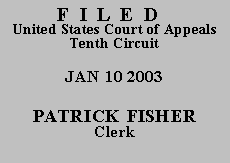

| KENNY TAYLOR,
v.
MICKEY RAY |
No. 02-3298
D.C. No. 01-CV-3439-RDR |
Taylor has already filed two successive motions challenging his sentence under § 2255, both which have been denied. His second § 2255 motion challenged his sentence precisely on Apprendi grounds. It was rejected because the rule in Apprendi may not be retroactively applied. United States v. Mora, 208 F.3d 228 (10th Cir. 2002).
Motions under § 2241, such as the one Taylor now files, are generally reserved to challenge the execution of a sentence rather than its validity. Bradshaw v. Story, 86 F.3d 164, 166 (10th Cir. 1996). The proper venue for attacking a sentence itself is under § 2255. 28 U.S.C. § 2255.
Nonetheless, as the magistrate judge and the district court found, Taylor's motion could not prevail under either statute. It could not prevail under § 2255 because successive § 2255 motions are barred unless the petitioner can prove actual innocence or the retroactive application of a new rule. See generally Antiterrorism and Effective Death Penalty Act of 1996 (AEDPA), 28 U.S.C. § 2255 (incorporating 28 U.S.C. § 2244). Taylor here makes no claim of actual innocence and, as discussed above, the rule in Apprendi may not be applied retroactively.
Taylor's claim could also not prevail under § 2241. Claims under § 2241 may only be made when the statute is the litigant's exclusive remedy. Here Taylor's claim is more properly brought under § 2255 because it challenges his sentence rather than the conditions of his confinement. Bradshaw, 86 F.3d at 166 (finding that a petition under § 2241 is not "an additional, alternative, or supplemental remedy to 28 U.S.C. § 2255"). The fact that Taylor has already been denied relief under § 2255 is not a reason for finding that alternative statute inadequate or ineffective as a remedy. Caravalho v. Pugh, 177 F.3d 1177, 1178 (10th Cir. 1999).
For substantially the reasons stated by the magistrate judge and the district court, we then AFFIRM the denial of Taylor's § 2241 motion. In the alternative, if his motion is construed as a successive petition under § 2255, we DENY Taylor a certificate of appealability and DISMISS the appeal. Mr. Taylor's motion to proceed in forma pauperis is denied.
ENTERED FOR THE COURT
David M. Ebel
Circuit Judge
*.After examining appellant's brief and the appellate record, this panel has determined unanimously that oral argument would not materially assist the determination of this appeal. See Fed. R. App. P. 34(a)(2) and 10th Cir. R. 34.1(G). The case is therefore ordered submitted without oral argument. This order and judgment is not binding precedent, except under the doctrines of law of the case, res judicata, and collateral estoppel. The court generally disfavors the citation of orders and judgments; nevertheless, an order and judgment may be cited under the terms and conditions of 10th Cir. R. 36.3.